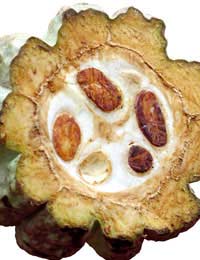How Chocolate is Made

The production of chocolate involves many different complex steps. Even the fertilisation of the flower to produce the cocoa bean is a complicated process; only 1% of each tree’s 6000 flowers will develop into a cocoa pod.
Harvesting the Cocoa
Each cocoa pod is around 15-30cm long and is yellow or red in colour. The fruits contain 25 to 50 seeds, which we know as the cocoa beans. After the creamy-coloured seeds have been removed from the pods, they are fermented in trays or heaps on the ground (sometimes they are covered in banana leaves). It is during fermentation that the beans turn brown and develop their distinctive flavour. The beans are dried, and then shipped to chocolate production factories where they are cleaned, hulled and then roasted.Preparing the Cocoa Beans
Roasting the beans helps make the separation of the shells and nibs easier. After the shells have been removed, the clean, cool nibs are refined. The nibs are blended in a similar way to coffee beans, to produce different colours and flavours. They are ground under rotating stones, discs, or rollers. The result is chocolate liqueur, a liquid that is more than 50 percent fat (cocoa butter).The chocolate liqueur is then mixed with the desired amount of ingredients such as sugar and milk solids (for milk chocolate). These ingredients are thoroughly blended and then conveyed to large refiners, which crush the mixture to create a smooth chocolate texture.
Conching
Conching involves heating the chocolate at high temperatures (54 –71C /130 –160ºF) and stirring it continually to form a pure, homogeneous liquid. At the same time, the mixture is exposed to a blast of fresh air. During conching, chemical changes occur that develop the chocolate's flavour. Additional flavourings, such as vanilla add a final hint of flavour. It is at this stage that other additives, such as lecithin (an emulsifier derived from the soybean) are added. Lecithin establishes the precise consistency necessary for using chocolate to make moulds (such as Easter eggs) or coatings.After conching, the chocolate is moved to tempering machines where it is poured into metal moulds or blocks. The filled moulds must then pass over a vibrating table to eliminate any air bubbles in the chocolate. The quality of the chocolate is based on the quality of the cocoa beans used and the conching process.
Using Chocolate in Confectionary
There are three key things chocolatiers need to get right when creating a luxury chocolate: quality of the ingredients, the blending technique and the filling.- The cocoa beans should be of exceptional quality, ideally from a crop growing very close to the Equator (where temperature and humidity conditions tend to make the most flavoursome beans).
- The chocolate needs to be carefully blended (conched) to give a smooth, rich taste and melt-in-the-mouth consistency.
- If a filling is used, it should be delicate and light, but rich enough to compliment the chocolate flavour.
- Quiz: What is Your Chocolate Personality?
- Quiz: Are You A Chocolate Addict?
- Planning a Chocolate-themed Garden
- Chocolate As A Cosmetic
- Chocolate Myths Explored
- Chocolate News: What's New
- Exploring Raw Chocolate
- Cocoa Solids: What They Are and Why They Matter
- How to Taste Chocolate
- Chocolate Techniques
- Chocolate & Health and Nutrition
- Uses of Chocolate
- Vegetarian & Vegan Chocolate
- About Organic Chocolate
- Chocolate as an Accompaniment
- Chocolate Facts
- History of Chocolate
- Alternatives to Chocolate


Re: Cocoa Solids: What They Are and Why They Matter
Lindt dark chocolate is available everywhere. The problem is they don't make organic chocolate.…
Re: Cocoa Solids: What They Are and Why They Matter
Great information but I don’t agree that all the bars with 100% cocoa solids tastes too bitter to eat on…
Re: Uses of Chocolate
It gives lots of information about chocolate.
Re: About Belgium Chocolate
what ingredients does belgian chocolate have that makes it nicer than original chocolate?
Re: About Latvian Chocolate
I work at a Hostel in San Francisco California (USA), Today a guest gave me and my wife a candy bar from LIETUVA. Now I have to say that…
Re: Making Chocolate Brownies
I love all chocolate brownies but i never put nuts in them (they were very delicious)
Re: Ghana: The Home of Chocolate
It's good to know that at last the locals are getting to know their own chocolate. Most harvesters/planters don't even know that…
Re: About Belgium Chocolate
We revere Belgian chocolate over here, and the good stuff really is delicious – and expensive. Over there, though, you can buy chocolates…
Re: White Chocolate
I cannot eat brown chocolate, milk or plain, as it causes terrible migraine. I can eat white chocolate with no problems but find it difficult to…
Re: The Perfect Chocolate Cake
Fabulous recipe, sooooo easy and tastes delicious.